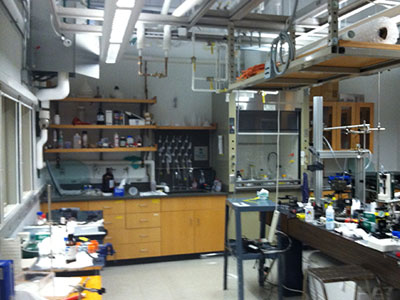
Kacey Suvada admits that before this summer, she had never spent all that much time considering the various ways liquids splatter, drip, splash and flow.
But then the Elmhurst junior spent 10 weeks working in the lab of University of Chicago physicist and fluid dynamics expert Sidney Nagel on a Research Experiences for Undergraduates (REU) grant.
“I had absolutely no idea about fluid dynamics before,” said Suvada, a math and physics major from Park Ridge, as she neared the end of her summer-long shift in the lab. “Now I’m working on all these really interesting programs that have to do with how liquids interact. It’s amazing.”
Suvada’s work this summer focused on Hele-Shaw Flow, the distinctive snowflake-like patterns that emerge when a quantity of one fluid is introduced to an extremely thin layer of another, more viscous fluid. With the help of colored dyes, experimenters can track the patterns that result as various liquids of different viscosities interact. Nagels’ lab also investigates the ways sand and other granular materials form and flow in fluids. So Suvada’s summer experiments had her working with salt, sugar, graphite powder and even that staple of craft stores and grade-school art projects, glitter.
The study of fluid and granular flow has diverse applications, ranging from plastics manufacturing to pharmaceuticals to the analysis of geological faults. But for Suvada, flow has a more basic appeal.
“It’s fun trying to understand the how and why of these problems,” she said. Then she added with a laugh, “And I get to wear a lab coat and work with blue food dye and glitter. How cool is that?”
Suvada said she was “ecstatic” when she learned she had been accepted for the REU. She was one of 20 undergraduates from around the country working at UChicago this summer, but the only one assigned to Nagel’s lab, which is also home to three postdoctoral researchers, six graduate students and one reptilian “lab mascot.” Suvada lived in university housing on UChicago’s Hyde Park campus and received a stipend as part of the program.
She said she appreciated the lab’s emphasis on experimentation. Early in her time there, she approached a graduate student for guidance on how to work out a problem she had been posed. How, she asked, had others set up similar experiments? The graduate student explained that there was no precedent; Suvada would be the first to do this particular test.
“I love that you don’t necessarily know the right way to do it,” she said. “Your job is to try to work it out, and if that fails, try again. I really like working so independently.”
She acknowledged, however, that her work did not always come off without a hitch. On her first day in the lab, as she was meeting Professor Nagel, she managed to splash blue food dye from her syringe onto one of the professor’s presentation posters. Suvada feared her time in the lab might end prematurely.
“But he was so chill. He said “If you’re not breaking something or ruining something in the lab, you’re not really doing science correctly,” Suvada recalled. Then she added dryly: “But you probably don’t want to ruin anything too expensive.”
The spirit of experimentation she found at UChicago reminded her of working with her Elmhurst physics professor, Venkatesh Gopal, himself an enthusiastic experimentalist.
“Dr. Gopal likes to say, ‘Don’t be afraid to get your hands dirty.’ You can’t be afraid to take a risk, and if you make a mistake, it’s not the end of the world,” she said. “He gave me the confidence to try things and, if one thing doesn’t work, try something different.”
One of the benefits of Suvada’s work at UChicago was attending weekly presentations by research faculty from the university’s other departments and institutes. Some of the talks she attended on problems in biophysics have her considering graduate work in the field.
“I really like the atmosphere here,” she said about working in UChicago’s celebrated science departments. “There are so many smart people here. And I’m finding that the smartest people are usually the most humble.”
Consider that another important lesson learned on a very illuminating summer job.